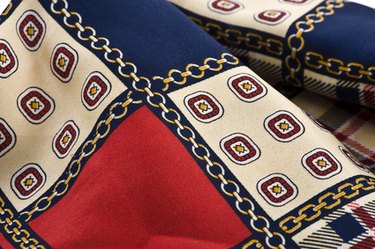
Fabric painting is a craftsmanship that began thousands of years ago in Asia and eventually expanded to other parts of Asia, Europe and Africa through trade routes. The technique has a deep history in Asia through Kalamkari, an ancient India art, and also in China and Japan, where other forms of patterning were developed. Now recognized on a global level, fabric painting is used on a daily basis as a hobby and for business.
History
Video of the Day
Fabric painting has been in existence since humans began weaving fibers together to form the first fabrics. As the earliest of humans painted their bodies, they began using those same techniques to paint the fabrics that they created. Two basic methods of fabric painting were used. Coloring was the process of directly applying an image with color to the fabric. Patterning was painting (or printing) with resists in patterns and then coloring the image on the fabric.
Video of the Day
Fabric Painting in Asia
According to the website Dharma Trading Co., "The continent of Asia has a long history of decorating fabrics. Printing blocks have been discovered that date back to around 3000 B.C." Fabric painting remained popular on the continent, and by the time Alexander the Great invaded India (327 B.C.), fabrics full of colorful printed and painted images were a normal possession among the people.
Kalamkari History
Originating in India around 1000 B.C., Kalamkari is an ancient Indian art that got its name from Kalam meaning "pen," and Kari meaning "work." The name meant "pen work." Kalamkari artists would use a bamboo stick or a date palm stick as the brush for painting. On the pointed end of the stick would be a bundle of hair that was used to spread the paint. According to the website Indiamarks, "These paintings were earlier drawn on cotton fabric only, but now we can see these paintings on silk and other materials as well."
Kalamkari Styles
The ancient art of painting in India mainly used organic colors and dyes. The majority of the colors were prepared by using the roots and leaves of plants, and mineral salts of iron, tin, copper and alum. The style of using the organic colors started in Kalahsti (which is 80 miles north of Chennai) and Masulipatnam (which is 200 miles east of Hyderabad). According to Indiamarks, at that time, the paintings would "depict Hindu deities and the scenes from Hindu mythology. With Masulipatnam being a Muslim region, the weavers were involved in the block printing art whereas the artists from Kalahasti practiced painting Hindu mythological scenes."
Fabric Painting Expands
After fabric painting had been present in India for hundreds of years, the fabrics were traded throughout Asia, Egypt and Greece. By 200 A.D., fabric painting expanded into parts of Europe and Africa. China began developing new techniques such as using resists and stencils, and the ideas spread to Japan, where the Japanese used the forms to create beautiful patterning on fabrics. Fabric painting continued to expand into other parts of the world including Peru and parts of South America. The technique is used today in America and in all parts of the world.